Related Research Articles
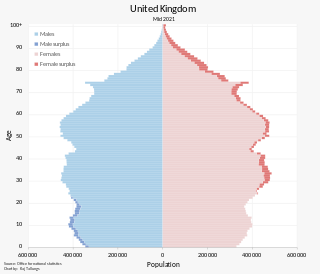
The population of the United Kingdom was estimated at over 67.0 million in 2020. It is the 21st most populated country in the world and has a population density of 270 people per square kilometre, with England having significantly greater density than Wales, Scotland, and Northern Ireland. Almost a third of the population lives in south east England, which is predominantly urban and suburban, with about 9 million in the capital city, London, whose population density is just over 5,200 per square kilometre.

Demographics of Wales include the numbers in population, place of birth, age, ethnicity, religion, and number of marriages in Wales.

The demography of England has since 1801 been measured by the decennial national census, and is marked by centuries of population growth and urbanization. Due to the lack of authoritative contemporary sources, estimates of the population of England for dates prior to the first census in 1801 vary considerably. The population of England at the 2021 census was 56,489,800.
The Office for National Statistics is the executive office of the UK Statistics Authority, a non-ministerial department which reports directly to the UK Parliament.

Inner London is the name for the group of London boroughs that form the interior part of Greater London and are surrounded by Outer London. With its origins in the bills of mortality, it became fixed as an area for statistics in 1847 and was used as an area of local government from 1855 to 1965 principally as the County of London or earlier as the Metropolitan Board of Works Area (metropolis). It now has two common definitions. The first is the statutory definition delineated in the London Government Act 1963, coming into force on 1 April 1965, comprising twelve Inner London boroughs and almost identical to the County of London that was abolished at the same time. The second is the definition used by the Office for National Statistics comprising eleven of the statutory Inner London boroughs and two of the statutory Outer London boroughs, as well as the City of London.
GSS codes are nine-character geocodes maintained by the United Kingdom's Office for National Statistics to represent a wide range of geographical areas of the UK, for use in tabulating census and other statistical data. GSS refers to the Government Statistical Service of which ONS is part.
A nationwide census, known as Census 2001, was conducted in the United Kingdom on Sunday, 29 April 2001. This was the 20th UK census and recorded a resident population of 58,789,194.

Religion in the United Kingdom, and in the countries that preceded it, has been dominated for over 1,400 years by various forms of Christianity, replacing Romano-British religions, Celtic and Anglo-Saxon paganism as the primary religion. Religious affiliations of United Kingdom citizens are recorded by regular surveys, the four major ones being the national decennial census, the Labour Force Survey, the British Social Attitudes survey and the European Social Survey.
In the United Kingdom, the Retail Prices Index or Retail Price Index (RPI) is a measure of inflation published monthly by the Office for National Statistics. It measures the change in the cost of a representative sample of retail goods and services.
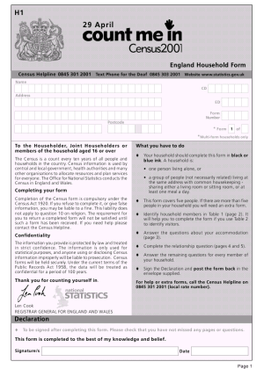
Coincident full censuses have taken place in the different jurisdictions of the United Kingdom every ten years since 1801, with the exceptions of 1941, Ireland in 1921/Northern Ireland in 1931, and Scotland in 2021. In addition to providing detailed information about national demographics, the results of the census play an important part in the calculation of resource allocation to regional and local service providers by the UK government.
The foreign-born population of the United Kingdom includes immigrants from a wide range of countries who are resident in the United Kingdom. In the period January to December 2016, there were groups from 22 foreign countries that were estimated to consist of at least 100,000 individuals residing in the UK.

The demography of London is analysed by the Office for National Statistics and data is produced for each of the Greater London wards, the City of London and the 32 London boroughs, the Inner London and Outer London statistical sub-regions, each of the Parliamentary constituencies in London, and for all of Greater London as a whole. Additionally, data is produced for the Greater London Urban Area. Statistical information is produced about the size and geographical breakdown of the population, the number of people entering and leaving country and the number of people in each demographic subgroup. The total population of London as of 2021 is 8,799,800.
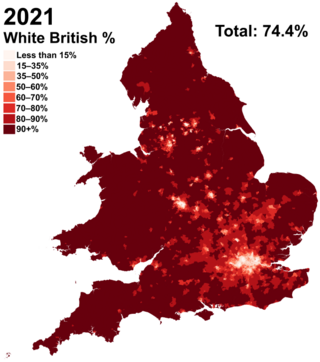
White British is an ethnicity classification used for the native white population identifying as English, Scottish, Welsh, Cornish, Northern Irish, or British in the United Kingdom Census. In the 2011 census, the White British population was 49,997,686, 81.5% of Great Britain's total population. For the United Kingdom entirely, due to different reporting measures within Northern Ireland which includes all those who identified as British with those who identified as Irish, an amalgamated total of 52,320,080 including those who identified as White Irish in Great Britain is given making up 82.8% of the population.
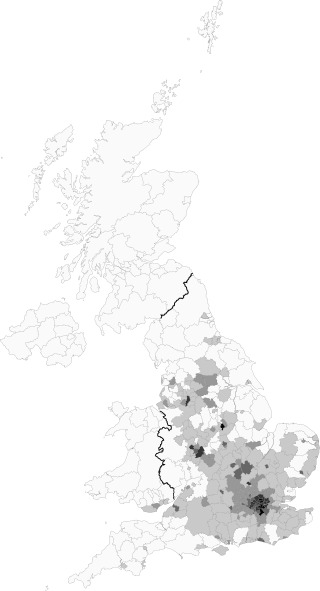
Mixed is an ethnic group category that was first introduced by the United Kingdom's Office for National Statistics for the 2001 Census. Colloquially it refers to British citizens or residents whose parents are of two or more different races or ethnic backgrounds. The Mixed or Multiple ethnic group in England and Wales numbered 1.7 million in the 2021 census, 2.9% of the population.
A number of different systems of classification of ethnicity in the United Kingdom exist. These schemata have been the subject of debate, including about the nature of ethnicity, how or whether it can be categorised, and the relationship between ethnicity, race, and nationality.

Since 1922 the United Kingdom has been made up of four countries: England, Scotland, Wales and Northern Ireland. The UK Prime Minister's website has used the phrase "countries within a country" to describe the United Kingdom. Some statistical summaries, such as those for the twelve NUTS 1 regions of the UK, refer to Northern Ireland, Scotland, and Wales as "regions". With regard to Northern Ireland, Scotland and Wales particularly, the descriptive name one uses "can be controversial, with the choice often revealing one's political preferences".
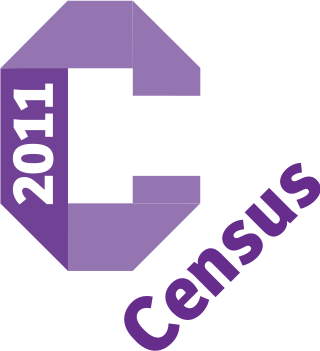
A census of the population of the United Kingdom is taken every ten years. The 2011 census was held in all counties of the UK on 27 March 2011. It was the first UK census which could be completed online via the Internet. The Office for National Statistics (ONS) is responsible for the census in England and Wales, the General Register Office for Scotland (GROS) is responsible for the census in Scotland, and the Northern Ireland Statistics and Research Agency (NISRA) is responsible for the census in Northern Ireland.
The Annual Population Survey (APS) is a combined statistical survey of households in Great Britain which is conducted quarterly by the Office for National Statistics (ONS). It combines results from the Labour Force Survey (LFS) and the English, Welsh and Scottish Labour Force Survey boosts which are funded by the Department for Education and Skills (DfES), the Department for Work and Pensions (DWP), the Welsh Government and the Scottish Government.

The 2021 United Kingdom census is the 23rd official census of the United Kingdom. Beginning in 1801, they have been recorded every 10 years. The decadal 2021 censuses of England, Wales, and Northern Ireland took place on 21 March 2021, and the census of Scotland took place 365 days later on 20 March 2022. The censuses were administered by the Office for National Statistics (ONS) in England and Wales, by the Northern Ireland Statistics and Research Agency (NISRA) in Northern Ireland, and by the National Records of Scotland in Scotland. These were the first British censuses for which most of the data was gathered online. Two of them went ahead despite the COVID-19 pandemic, in part because the information obtained would assist government and public understanding of the pandemic's impact. The census-taking in Scotland was postponed, and took place in 2022 because of the pandemic.

White: Gypsy or Irish Traveller is an ethnicity classification used in the 2011 United Kingdom Census. In the 2011 census, the White: Gypsy or Irish Traveller population was 63,193 or about 0.1 per cent of the total population of the country. The ethnicity category may encompass populace from the distinct ethnic groups of Romanichal Travellers or Irish Travellers, and their respective related subgroupings, who identify as, or are perceived to be, white people in the United Kingdom.
References
- 1 2 The census and future provision of population statistics in England and Wales UK Statistics Authority published 27 March 2014, Accessed 1 April 2014
- 1 2 Plans for a Census in Scotland in 2021 National Records for Scotland Press Release 27 March 2014 Archived 7 April 2014 at the Wayback Machine
- ↑ Census Transformation Programme ONS, Accessed 25 January 2015
- ↑ Davis, David (May 2013). "The Householders' Schedule in the 1841 Census". The Local Historian. British Association for Local History. 43 (2): 90–104.
- 1 2 3 4 Background to Beyond 2011 Office for National Statistics website, Retrieved 14 July 2013
- ↑ Counting The Population House of Commons Treasury Committee Published House of Commons Date 14 May 2008, Retrieved 14 July 2013
- 1 2 Dugmore, Keith; et al. (4 July 2011). "Beyond the 2011 Census in the United Kingdom" (PDF). International Journal of Market Research. 53 (5). doi:10.2501/IJMR-53-5-619-650. S2CID 167885714 . Retrieved 15 July 2013.
- ↑ Background to Beyond 2011 General Registrar's Office for Scotland Archived 6 August 2013 at the Wayback Machine , Retrieved 15 July 2013
- ↑ About the Northern Ireland Census 2011 NISRA, Accessed 4 May 2014
- ↑ Beyond 2011 The UK Context, retrieved 4 September 2013
- ↑ Beyond 2011 - The UK Context Office for National Statistics website, Retrieved 14 July 2013
- ↑ Beyond 2011 The future of population statistics Presentation by ONS 9 May 2012, Retrieved 15 July 2013
- ↑ Beyond 2011 Progress Report January - September 2012 - Office for National Statistics website, Retrieved 17 October 2013
- ↑ The Options at a view: the new shortlist Office for National Statistics website, Retrieved 14 July 2013
- ↑ Office for National Statistics website, Retrieved 14 July 2013
- ↑ Beyond 2011: Newsletter – May 2013 Office for National Statistics website, Retrieved 14 July 2013
- ↑ The census and future provision of population statistics in England and Wales ONS September 2013 Archived 26 November 2013 at the Wayback Machine , Retrieved 26 September 2013
- ↑ Options for the Future of the Census in England and Wales ONS Beyond 2011 Programme, Accessed 3 September 2013
- ↑ Beyond 2011 Newsletter July 2013, Retrieved 3 September 2013
- ↑ Beyond 2011 Consultations Report Summary of the uses of census information. ONS Archived 19 October 2013 at the Wayback Machine , Retrieved 18 October 2013
- ↑ Beyond 2011: Independent Review of Methodology Published by ONS November 2013, Accessed 1 April 2014
- ↑ Too soon to scrap the Census - UK Parliament Public Administration Committee Report Published 9 April 2014, Accessed 1 May 2014
- ↑ Beyond 2011 Research Conference 2014: Summary of proceedings - August 2014, Accessed, 30 August 2014
- ↑ FAQ Census Transformation Programme, Accessed 25 January 2015